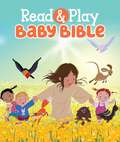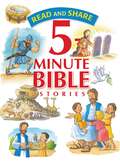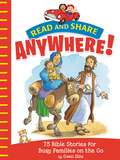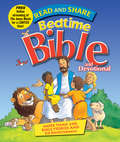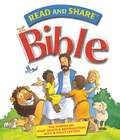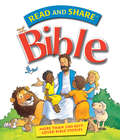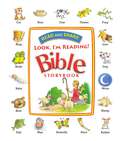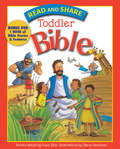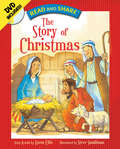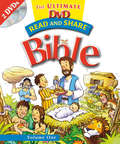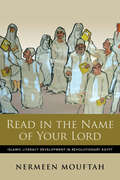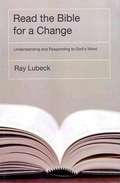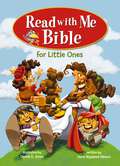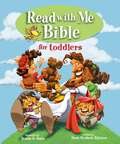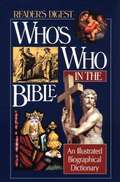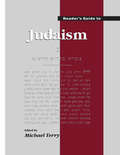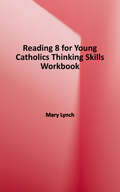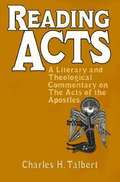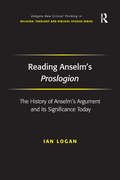- Table View
- List View
Read and Learn Bible
by American Bible SocietyTimeless stories from the Bible for children and parents to share. Parents and children can deepen their understanding of the Bible by reading Bible stories together. The Read and Learn Bible features stories from the Old and New Testament including: Genesis, Noah and the Flood, Exodus, Daniel in the Lion's Den, The Story of Queen Esther, The Nativity, Jesus the Teacher, Jesus Comes to Jerusalem, and many more. Illustrated in full color with callouts to help deepen the meaning of the stories, and parent pages to help in discussion, this is a Bible that children can share with their parents, and that parents will want to share with their children.
Read and Play Baby Bible
by ZondervanThe Read and Play Baby Bible offers parents priceless opportunities to cuddle up with their child and enjoy time together learning about God&’s Word. With 22 fun stories written just for little ones and activities like tickling bellies and singing along with David and his harp, children will learn that God loves and cares about them. The Read and Play Baby Bible fill story time with lots of love, hugs, and kisses.
Read and Share 5-Minute Bible Stories
by Thomas NelsonGet ready for some big adventures!Noah built a big boat and David took down a giant. Beautiful Queen Esther saved her people. Jesus healed a sick boy and stopped a storm! What will happen next?Ninety exciting adventures will capture your little ones&’ hearts and minds in Read and Share 5-Minute Bible Stories. Perfect for reading aloud in about five minutes, these stories from both the Old and New Testament are told in kid-friendly language. Plus, closing questions and thoughts for discussion help parents guide toddlers&’ and preschoolers&’ understanding—and keep them looking forward to the next story time.In just a few minutes, you can help your precious children discover the wonder of God&’s Word!
Read and Share Anywhere!: 75 Bible Stories for Busy Families on the Go (Read and Share)
by Gwen EllisWith 75 beloved Bible stories, Read and Share Anywhere! combines time-honored favorite Bible stories from the Old and New Testaments paired with Scripture verses, questions, and prayers to encourage more engagement with toddlers and preschoolers. More than 1 million families have trusted Read and Share for developing their child's faith.With our busy, on-the-go lives, these short stories can travel with your family anywhere! Each story will capture your little ones' hearts and minds and are perfect for reading aloud. The kid-friendly language and bold, colorful illustrations make this a family favorite that will help your children grow in their faith and love of God.The backpack-size book makes for an easy grab-and-go option and provides a durable, portable way to keep kids entertained. Read and Share Anywhere! is a perfect size for church, car trips, travel, doctor visits—any place for on-the-go families.
Read and Share Bedtime Bible and Devotional
by Gwen EllisEasy-to-understand Bible stories and fun devotionals are the perfect way to send little ones to bed feeling safe and blessed.Perfect for bedtime--or anytime--the Read and Share® Bedtime Bible and Devotional will be parents' go-to source for teaching children the stories of the Bible and sharing the amazing joy and wonder of God's Word. More than 200 Bible stories and 50 devotionals feature memory verses, songs, activities, prayers, and discussion starters. The text and art have been carefully evaluated to attain the highest level of accuracy and age-appropriate topics, and the bold, bright illustrations will capture a child's imagination.With more than one million Read and Share products sold, the Read and Share Bedtime Bible and Devotional is ideal for young families who are looking for tools to help teach their children about sharing God's love and who are want to make the most of the time they spend together.
Read and Share Bible - Pack 6: The Stories Of Jesus' Death And Resurrection
by Gwen EllisIt is big and bright with lots of page-turning learning about the Word of God.The Read and Share Bible is unique in its format and solid in Bible teaching. Packed with stories that are simple re-tellings, the gigantic message of God's love and care is sure to win the hearts of little ones and give them a strong Bible foundation to guide their lives. This Bible Storybook is highly interactive as it encourages Scripture Memory and reinforces comprehension with quick activities for you and your children.Stories in Pack 6 include Jesus' Death and Resurrection, Acts, & Paul's Letters as well as many other timeless Biblical characters and lessons.
Read and Share Bible: More Than 200 Best Loved Bible Stories
by Gwen EllisIt is big and bright with lots of page-turning learning about the Word of God.The Read and Share Bible is unique in its format and solid in Bible teaching. Packed with 200 stories that are simple re-tellings, the gigantic message of God's love and care is sure to win the hearts of little ones and give them a strong Bible foundation to guide their lives. With over 400 pieces of art, this Bible Storybook is highly interactive as it encourages Scripture Memory and reinforces comprehension with quick activities for you and your children.Stories include Noah, David, Joseph, Abraham, Paul, and Christ as well as many other timeless Biblical characters and lessons.
Read and Share Devotional
by Gwen EllisThis perfect companion to the Read and Share Bible® helps parents teach their young children about God's Word!With 52 Bible stories and fun activities, this book provides easy access to age-appropriate topics, prayers, Bible stories, and activities that encourage sharing God's love with others. Stories emphasize such topics as helpfulness, forgiveness, love, and fear. It's perfect for young families who are looking for tools to help them teach their children about God's love and who want to make the most of the times they spend together.Each devotional contains a variety of topic introductions (ranging from songs and poems to recipes and stories), a Bible verse (short enough for a child to memorize), a Bible story, Let's Talk About It questions, a Share God's Love activity, a prayer, plus engaging four-color art.(Formerly titled Our Together-Time Bible.)
Read and Share Look, I'm Reading! Bible Storybook
by Gwen EllisWith more than 1.3 million sold in the Read and Share® brand, this is the perfect next step!Your family will love this Bible storybook in the popular rebus style with pictures sprinkled between words, allowing your little ones to read along with you! Kids will love to engage with the Bible stories by pointing out the pictures among the words to tell the story. This is a proven way to help children learn and retain the stories through interaction. In the rebus format, children see the picture key, learn the word, and then complete the sentence using the correct picture. This gives children positive learning and interactive reading time.Stories include: Adam and Eve and the Sneaky Snake, Noah and the Big Boat, Moses and the Ten Commandments, David and the Giant, Mary&’s Big Surprise, Jesus Stops a Storm, Jesus Goes to Heaven, and A Promise to All God&’s Children.
Read and Share Toddler Bible
by Gwen EllisThis new addition to the Read and ShareTM brand contains 40 stories plus a 60 minute DVD including bonus features just for toddlers. The Read and Share Toddler Bible is a delightful way to introduce little ones ages one to four to God's Word. Gwen Ellis's engaging retelling of Bible stories along with Steve Smallman's colorful art communicate God's Word clearly to small tots with short attention spans. Stories from both the Old and New Testaments include all-time favorites ranging from Creation, Noah, Moses, Abraham, Isaac, Joseph, David, to Jesus' birth, miracles, death, and resurrection. Bonus DVD includes stories and bonus features from the popular Read and ShareTM DVD Bible series. Each story is three minutes long to keep toddlers attention span engaged.
Read and Share: The Story of Christmas
by Gwen EllisThe Story of Christmas from the Read and ShareTM Bible is a colorful retelling of the birth of Christ and the events surrounding it.Based on the International Children's Bible, this book begins with the birth of John the Baptist. Next comes the angel appearing first to Mary, then to Joseph, the trip to Bethlehem, the birth of Jesus, the angel's announcement to the shepherds, the wise men and their gifts, fleeing to Egypt, and at last heading home to Nazareth. The "Can You Retell the Story" activity at the end of the book is a fun way for children to learn to tell the story themselves.The animated DVD includes a 15-minute story plus coloring pages and other bonus features.
Read and Share: The Ultimate DVD Bible Storybook - Volume 1
by Gwen EllisA book and DVD combination to help share the joy and wonder of God'sWord with the children in your life.These bite-size vignettes inbook and DVD presentations are perfect for the attention span of little ones,and give parents maximum flexibility to fit any time frame. This volumecontains more than 100 beloved Bible stories, including time-honored favoriteslike Creation, Adam and Eve, Noah and the flood, Abraham, Isaac, Jacob, Samson,Ruth and Naomi, Samuel, David and the Giant, Elijah, Esther, Shadrach-Meshach-Abednego,John the Baptist, Jesus' Birth, Stories from Jesus' Life and Ministry, Saul Becomes Paul, Paul's Travels,Paul's Shipwreck, and many more.
Read in the Name of Your Lord: Islamic Literacy Development in Revolutionary Egypt (Public Cultures of the Middle East and North Africa)
by Nermeen MouftahEgypt's January 2011 uprising spurred millions to action with a cacophony of demands—including the call to address Egypt's education crisis and adult literacy rates. Read in the Name of Your Lord traces the push for universal literacy as a project caught between revolutionary activism and Islamic reformism in post-Mubarak Egypt. Despite their many disagreements, religious reformers, revolutionaries, and state actors converged on literacy as the first step toward realizing aspirations of the revolution. They invoked the verse Muslims believe was the first to be revealed, "Read in the name of your Lord," to teach literacy as a religious duty and the foundation for the country's future. Nermeen Mouftah unravels how this religiously inspired push for universal literacy was born of twenty-first-century scripturalism and simultaneously went beyond the Quran, to make reading and writing virtuous acts of the liberal state. While revolutionary literacy campaigns soon vanished and adult literacy rates remained stubbornly low, their efforts revealed the importance of recognizing alternative modes of text processing and the personhood and knowledge of nonliterate people. Read in the Name of Your Lord demonstrates how the rise in modern scripturalism underpinned literacy activism, blurring the binary between secular and religious knowledge.
Read the Bible for a Change: Understanding and Responding to God's Word
by Ray LubeckWhich Bible passages are for us today and which only apply to the first audience ancient readers? Can we just pick and choose for ourselves the verses we think fit our situation? Who gets to decide?
Read with Me Bible for Little Ones
by ZondervanThe Read with Me Bible for Little Ones is this perfect way to introduce the Bible to young children. Featuring simple language and vibrant, full-color illustrations by Dennis Jones, this action-packed book is a great way to jump-start literacy and a love of the Bible.
Read with Me Bible for Toddlers
by Dennis Jones Doris RikkersThe Read with Me Bible for Toddlers: Children will love it. Vibrant, action-paced full-color art by Dennis Jones brings 24 of the Bible’s best-loved stories to life. Children will love looking at the pictures as you read the delightful simple words and short sentences. Share the excitement of God’s Word with your little one. Give them the Read with Me Bible for Toddlers!
Reader's Digest Who's Who in the Bible: An Illustrated Biographical Dictionary
by The Editors Of The Reader's DigestFrom prophets and kings to servants and beggars, the Bible is filled with fascinating characters whose stories make captivating reading. This comprehensive, A-Z arranged reference helps readers sort out these compelling and colorful personalities.
Reader's Guide to Judaism
by Michael TerryThe Reader's Guide to Judaism is a survey of English-language translations of the most important primary texts in the Jewish tradition. The field is assessed in some 470 essays discussing individuals (Martin Buber, Gluckel of Hameln), literature (Genesis, Ladino Literature), thought and beliefs (Holiness, Bioethics), practice (Dietary Laws, Passover), history (Venice, Baghdadi Jews of India), and arts and material culture (Synagogue Architecture, Costume). The emphasis is on Judaism, rather than on Jewish studies more broadly.
Readiness for Religion: A Basis for Developmental Religious Education (Routledge Library Editions: Education and Religion #5)
by Ronald GoldmanIn this study, first published in 1965, the author explores the implications of research for an alternative approach to religious education. The book deals with the psychological bases of religious development, reviewing the natural limitations as well as the basic needs of the young, and how religious education should be affected by educational theory and practice. The author also examines what content and methods of teaching are consistent with the healthy development of children and adolescents. Teachers in schools, students in training, lecturers, clergy and ministers, and local education authority committees will welcome the book as an important aid to the task of rethinking syllabuses and the need for more child-centred methods of teaching.
Reading 4: I Met You in a Story (2nd Edition)
by Bob Jones UniversityThe book includes stories around six character themes. It includes classic literature excerpts, character-building stories, and activities that build research and literary skills.
Reading 5 for Christian Schools: Pages in My Head
by Bob Jones UniversityReading 5 Student Text equips students to improve in reading, comprehensive and thinking skills. It contains a great collection of literature.
Reading 8 For Young Catholics
by Mary LynchThis is a workbook from Seton Press. Students develop reading and comprehension skills while learning to love the Church's heritage. Thirty-six lessons each contain a saint story and comprehension questions. Application of the book's content to daily Catholic life is encouraged.
Reading Acts: A Literary and Theological Commentary on the Acts of the Apostles (Reading The New Testament)
by Charles H. TalbertAnswers to the usual introductory questions do not yield sufficient harvest to enable an intelligent reading of Acts. The approach of Reading Acts is to ask how ancient Mediterranean auditors would have heard Acts when it was read in their presence. To be successful Talbert divides this approach into two parts--how Acts would have been heard in its precanonical context and in its canonical context.
Reading Adorno: The Endless Road
by Amirhosein KhandizajiThis book draws on core concepts coined by Adorno, such as identity thinking, the culture industry, and his critique of the autonomous and rational subject, to address the ills that plague neoliberal capitalist societies today. These ills range from the risk of a return to totalitarian tendencies, to the global rise of the far-right, and anti-feminist conceptions of motherhood. Subsequent chapters outline the ways in which Adorno's thought can also be seen to redress the challenges of modern societies, such as the critical function of artworks, and the subversive potential of slow-food and popular music. The important underlying concern of the book is to highlight the continuing relevance of Adorno, both in dealing with the failures of neo-liberal capitalist societies, and in his applicability to a wide range of disciplines.
Reading Anselm's Proslogion: The History of Anselm's Argument and its Significance Today (Routledge New Critical Thinking in Religion, Theology and Biblical Studies)
by Ian LoganAnselm’s Proslogion has sparked controversy from the time it was written (c.1077) to the present day. Attempts to provide definitive accounts of its argument have led to a wide and contradictory variety of interpretations. In this book, Ian Logan goes back to basics, to the Latin text of the Proslogion with an original parallel English translation, before tracing the twists and turns of this controversy. Helping us to understand how the same argument came to be regarded as based on reason alone by some and on faith alone by others, as a logically sound demonstration by its supporters and as fatally flawed by its opponents, Logan considers what Anselm is setting out to do in the Proslogion, how his argument works, and whether it is successful.

